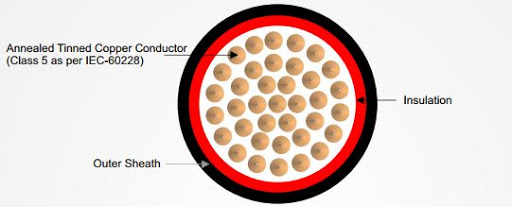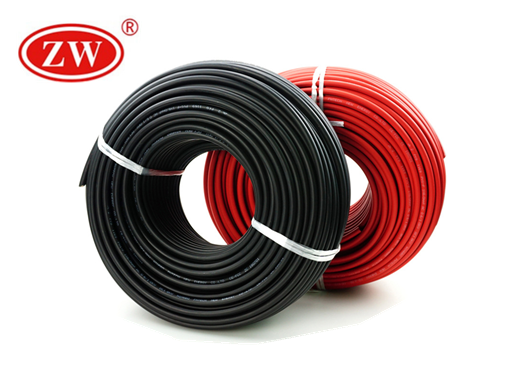They connect the components of a circuit and serve as a conduit where electricity travels. If you’re a total newbie in photovoltaic systems, learning the basics of solar wires and cables is vital.
Usually, you mount solar panels on the roof or an elevated structure to avoid any obstruction. These panels harness solar energy and transform it into usable electrical current. Once solar energy converts to usable electric power, solar wires and cables then transport it to the electrical units..
A well-planned and properly installed network of solar cables and wires ensure safe and optimal function of a PV system. PV wiring design entails the appropriate use of solar wires and cables.
Although people use the terms solar wire and solar cable interchangeably, they are different. Solar wire refers to a single conductor, while solar cable is a composite of several conductors or wires held together by a jacket.
Solar wires, used to connect the components of a photovoltaic system, come in various types. Typically, it connects four components: the solar panel, the inverter, the charge controller and the batteries.
Choosing an appropriate type of wire in a PV system is crucial to its operation and efficiency. Using a wrong solar wire might not deliver the appropriate voltage and fail to power up the electrical units or result in the battery bank’s failure to charge fully.
Wire composition
In general, there are two types of solar panel wires either single or stranded wire. As the name suggests, single or solid wire contains single metal wire core while stranded wire consists of multiple stranded conductors.
A protective sheath insulates the single wire, but there are also bare wires. Solid wire type is recommended for static application, particularly for domestic electrical wiring. For the same carrying capacity, solid wires are more compact in diameter compared to stranded wires. Single wire costs less, but is available only in small gauges.
As mentioned above, the stranded wire consists of several conductors twisted together and covered with jacket to form a multi-strand wire. Stranded solar wire is more flexible and has the ability to sustain frequent movement. The recommendation is to use standard wire if you install your solar system in a location with high winds or subjected to frequent vibration. Since there are several conductors in a single run, stranded wire offers better conductivity. Compared to solid wire, stranded wire has larger diameter and is more costly. Standard wire is the typical choice for larger and outdoor installations.
Wire material
Solar wires can also be classified based on the conductor material used. For domestic and commercial installations, the use of aluminum and copper solar wires is common.
Copper wire has superior conductivity compared to aluminum. The same copper solar wire size carries more current than aluminum. Copper offers flexibility and better heat resistance. It supports both indoor and outdoor applications. However, copper wires are more expensive. Solar panel cables Meanwhile, cheaper aluminum wires are more rigid and weaken when bent. They come in larger gauges and typically used for outdoor installations, such as for service entrances.

Wire insulation
Solar wires also differ based on their insulation. This sheath protects the cable from the elements such as moisture, heat, chemicals, water, and ultraviolet light. Commonly used insulation types include:
· THHN for applications installed on dry, indoor conditions;
· TW, THW and THWN for conduit applications installed in wet, indoor or outdoor conditions;
· UF and USE (underground service entrance) for wet, underground wiring, though not restricted to underground applications;
· THWN-2 for indoor applications, less expensive. Since it runs through conduit, it does not have to be UV resistant. THWN-2 can run directly to the Main Service Panel. It can be used for both DC circuits and AC circuits, although the sizing should change after the wiring passes through the inverter;
· RHW-2, PV Wire and USE-2 solar cable for moist, outdoor applications. These types of wires are ideal for wiring solar panels, service terminal connections and underground service entrances. The jackets of PV wire and USE-2 handle extreme UV exposure and are moist-resistant. PV wire comes equipped with an added layer of insulation.
Wire color
Color-coded solar wires make it easier to execute and map out the electrical wiring plan. The wire color designates its purpose and function the solar system. It is also essential for future troubleshooting and repair. The National Electrical Code designates the conductor insulations and applications.
The color coding for Alternating Current (AC) and Direct Current (DC) differ. Here’s a quick color-coding guide for simple electrical wiring installations.
· AC applications
· Red, black or other color for un-grounded hot applications
·White for grounded conductor
· Green or bare for equipment grounding
· DC applications
· Red for positive pole
· White for negative pole or grounded conductor
· Green or bare for equipment grounding
When installing electrical systems, it is important to follow the recommendations of the National Electrical Code (NEC). If you are unsure about which conductor and insulation to use for a specific application, it is best to seek the help of a certified electrician.
Wire rating and thickness
PV wires have ratings based on their maximum amperage capacity. Basically, solar panels with higher amperage (current) require thicker solar wire with higher rating. Be sure to check the amperage rating of your system and use wire that can handle the load. For example, if it produces 9 amps, use 9-amp wire or a little higher (10 or 11 amps).
Choosing solar wire with lower rating can cause voltage drop. Over time, it can lead to overheating and even increase the risk of fire.
Solar wire thickness is often relative to its amp. The thicker the wire; the higher the amp capacity. As a rule of the thumb, always use a wire that is either thick enough or a little thicker to handle occasional power surges. Identify the appliance with the highest amperage and choose a wire capable of handling this current. To guide you better, use a wire sizing estimator available online.
Size copper solar PV wires using the American Wire Gauge (AWG) scale. In the AWG system, as the AWG number goes up, the wire becomes smaller. So, a 2 AWG solar wire has a larger diameter than a 12 AWG
wire. However, the wire size is inversely related to the amp capacity of the wire. For example, 2 AWG solar cables have a capacity of 95 amps, while 12 AWG solar wire has a capacity of 20 amps.
Wire length
Aside from the solar wire rating and thickness, consider its length as well. The longer the distance electricity travels, the higher the amp it expends. Always use a wire that is a little thicker for added safety, especially when it will run a considerable length.
For example, if an installation runs 5 meters with a maximum of 10 amps and 3% acceptable cable loss, you can use solar cable 6mm. However, if the same installation runs 15 meters, it requires solar cable 25 mm. Again, using wires with lower rating increases the risk of voltage drop, overheating and fire. Electricians also recommend preparing for future load requirements; hence, it is always safe to use thicker wires on initial installation
Solar Cable
Solar cable is a composite of several insulated wires enveloped by an outer jacket. Professionals use them to interconnect solar panels and other components of a photovoltaic system. They handle high UV radiation, high temperatures, and are weather resistant. Usually, they are installed outside or within the solar panels.
A cable varies in diameter depending on the number of conductors it contains. Classification of Solar cables is based on the number of wires and their gauge. In general, there are three types of cables used in a PV system: DC solar cables, solar DC main cables, and solar AC connection cables.
DC Solar cable
DC solar cables can either be module or string cables. Typically, these are single core copper cables with insulation and sheathes. Used within the PV solar panels, they come with suitable connectors. DC solar cables are pre-built into the panels, so you won’t be able to change them. In some cases, you’ll need string DC solar cable to connect it with other panels.
Main DC cable
Main DC cables are larger power collector cables that connect the positive and negative cables from the generator junction box to the central inverter. Typical sizes of main DC cable are solar cable 2mm, solar cable 4mm, and solar cable 6mm.
Experts typically favor DC cables for outdoor installation. To avoid short circuit and grounding problem, lay cables carrying opposite polarities apart from each other.
Main DC cable can either be single- or two-core cable. Single-core wires with double insulation are a practical solution that offers high reliability. Meanwhile, for wiring between solar power inverter and generator connection box , two-core DC cables are a typical choice..
AC connection cable
The AC connection cable interconnects the solar power inverter to the protection equipment and the electricity grid.
For small scale solar systems with three-phase inverters, a five-core AC cable is used to connect to the grid. The distribution of the wires is as follows: three live wires for carrying electricity, and one each for ground and natural wire. Meanwhile, use a three-core AC cable for PV systems with single-phase inverter.
Final Thoughts
As emphasized above, choosing the appropriate size of cable is extremely important in a PV system. Properly sizing the cables prevents overheating and reduces energy loss. Aside from safety concerns, using undersized cable is a violation of the National Electric Code (NEC) in most jurisdictions. If you use a wire that is not compliant with the regulations, the building inspector will fail your installation.
In general, there are two main factors that determine the solar wire size. These include the generating capacity of the solar panel and the length of the source to the electrical units. Other factors to consider include the wire application and environmental condition for the installation.
Before you buy cables solar cables for your PV installation, you or your installer must be proficient on calculating cable and wire size. You should be familiar with, and adhere to, the regulations set forth by the NEC. Local building inspectors will verify if your electrical installation meets the standards.
Take note, however, that the wiring standard gets updated every three years, with the 2020 edition being the latest. These changes reflect the developments in the world of electrical engineering. It ensures the safety of all electrical installations through the use up-to-date methodologies and materials. Before starting any PV installation, it is best to check with your local authorities which edition is in use. This can help you plan appropriately. Lastly, if you are unfamiliar with these regulations, we recommended that you consult a certified electrician.